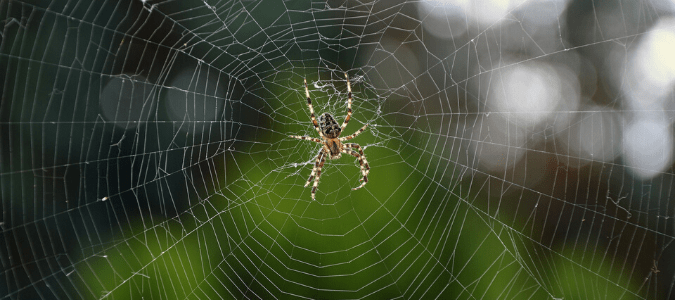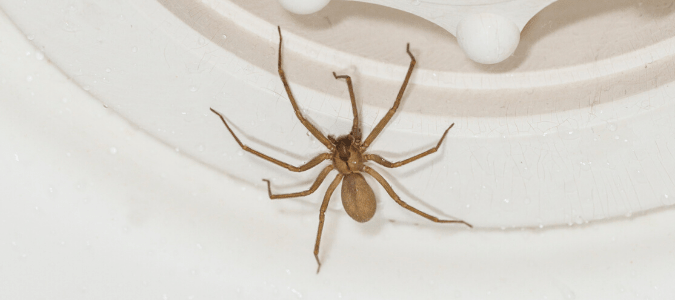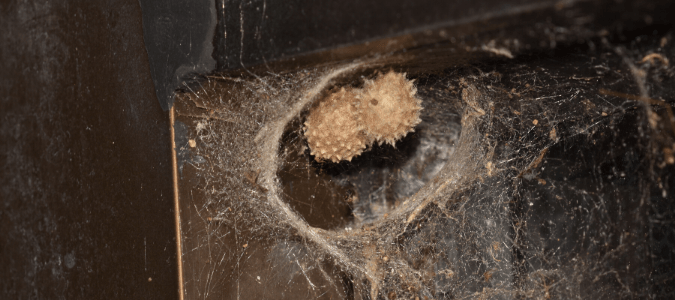
It started with just one or two spiders that you were able to quickly deal with. Then, you started noticing more and more of these creepy crawlies on your property. At this point, the frequency at which you’re finding spiders in your home and yard is making you uncomfortable. When faced with the reality that your resident spider population exceeds your comfort level, you’re likely wondering what is attracting spiders to your property. And once you get an answer to that question, you’re probably wanting to know what can you do to get rid of them.
Spiders are predators that gravitate towards areas in which they can find food. In other words, if there are bugs in your yard, it’s highly likely that there will be at least some spiders. If you do have some bugs on your property (as most of us do), the spider population can grow, and some of these arachnids may start to invade your home. Aside from looking for food, some spiders may wander their way into your home or garage while searching for a mate.
Spiders typically congregate in dark, secluded, still areas. That’s why spiders are commonly found in attics and garages, as well as in outdoor areas, including woodpiles, overgrown shrubs and sheds. Even damaged parts of your home, like a hole in the eaves or cracks in your siding, can shelter spiders. This is unfortunate because, for many people, there are few creatures that are creepier than spiders. Beyond this, a spider infestation can also be potentially dangerous, depending on the species of spider that moves in. To keep spiders from setting up shop in and around your home, you need to implement measures to make your property less appealing to these creatures. While you may not be successful in eliminating every single spider, with some consistent effort, you can keeping the population of spiders in your home and on your property down to a more comfortable level.
If you want to try to control your spider population on your own, the first step you’ll need to take is to get rid of the spiders’ food source. Unfortunately, this is easier said than done, because spiders will eat a wide variety of other common insects, including mosquitoes, flies and mites. Homeowners wondering what eats roaches are surprised to learn that spiders are even on the list. Therefore, if your top priority is keeping spiders away, you need to figure out what the spiders are eating and get rid of that population first.
Outdoor lights attract bugs, including spiders, from a wide surrounding area. That means you’ll often find spiders congregating on and near porches, patios and entryways where we might have sconces or other lighting in order to catch those bugs. Keeping your outdoor lights off as much as possible at night will cut off this food source and discourage spiders from gathering there, making it harder for them to make their way indoors.
Infestations of other bugs will often lead to a spider infestation as well. If your yard has a lot of mosquitoes, for example, spiders will often follow. However, when you take care of the mosquito problem, the spiders may start to look elsewhere for food.
When you’re finding an unusually high number of spiders indoors, this is usually the result of indoor conditions becoming more attractive. When it’s particularly hot and dry or cold and wet, spiders and other unwanted bugs and animals seek shelter and sometimes get invade our homes. To keep spiders out, you should make sure your foundation doesn’t have any cracks or crevices, and that your window and door frames are tightly sealed. This will help minimize the number of potential entry points for spiders.
To make your outdoor areas less attractive to spiders, you can also work to clear brush and debris away from the foundation of your home. Overgrown shrubs or piles of leaves up against your foundation can be a perfect home for spiders. Once spiders have started aggregating next to your home’s exterior, it becomes much more likely that a few will start to make it inside.
One benefit of taking steps to deter spiders is that these same methods usually work to control common household pests in general. To summarize, here are a few other measures you can take to make your property less attractive to spiders and other unwelcome bugs and critters:
- Frequently sweeping and vacuuming
- Sealing up storage bins and keeping them off the ground
- Clearing any vegetation or brush around your home’s exterior
- Sealing any cracks in your foundation
- Tidying up clutter in your home, yard, shed and garage
- Signing up for ongoing pest control services
There are a few types of spiders that commonly wind up in homes, some of which are completely harmless. Being able to distinguish between house spiders and brown recluse spiders is important because the brown recluse is venomous.

House Spider vs. Brown Recluse: How Do I Tell Them Apart?
If you feel as though you are having too many close encounters with spiders in and around your home and you’re not sure what species you’re dealing with, don’t hesitate to contact a professional. A pest control specialist will be able to tell you whether you have a venomous brown recluse, or whether you are just dealing with a house spider. No matter what type of unwanted creature you have hanging around, a licensed technician can help create a pest control treatment plan that’s customized for your situation which can both address your current problem and help prevent future infestations.
Common house spiders, also known as American house spiders, are the most frequent visitor in most homes. These small spiders range from an eighth to a quarter of an inch wide. They’re not venomous and they’re not aggressive. Many will even tolerate you scooping them up and moving them outside without reacting—that is, if you’re brave enough to do the job.
All common house spiders have yellow or orange legs with dark stripes. These species have mottled, dark brown bodies, with dark markings on their bellies. Common house spider webs typically have a section of the web that is thicker than the rest. A spider may add a leaf or two to the web so it can hide from its prey.
Common house spiders do not have the violin pattern on their back like the brown recluse. Without that pattern, it’s safe to say the spider isn’t a brown recluse spider.
Southern house spiders are another type of arachnid you may come across which is relatively large, sometimes with bodies growing up to three-quarters of an inch long and their legs extending out past that. Female southern house spiders are charcoal gray, while males are tan or brown. They both have a violin shape on their back like the brown recluse spider, but they are not venomous to humans. Visually, it can be difficult for most non-experts to tell the difference between a southern house spider and a brown recluse.
One way you can tell the difference between the southern house spider and a brown recluse is where you find it. Southern house spiders prefer high spaces and corners. Their webs appear tangled and sometimes funnel-shaped. These webs are used to collect food, so pieces and parts of dead bugs are often found in them.
Brown recluse spiders are some of the most dangerous spiders in North America. Their bite can lead to tissue necrosis, along with other unpleasant side effects. Identifying a brown recluse spider can help you get appropriate treatment for a bite and prevent more serious consequences.
As you can see in the image above, brown recluse spiders have a violin-shaped pattern on their back. This pattern starts at the front of their head and moves backward, so it appears that their eyes are at the base of the violin. Outside of that dark brown marking, brown recluse spiders are a uniform mid-brown color, without other stripes or patterns. Although some people may confuse brown recluses and wolf spiders, wolf spiders are much larger and do not have the violin pattern.
Brown recluse spiders don’t always build webs, but when they do the webs are near ground level. These spiders are active hunters, so they go in search of their prey. When they aren’t hunting, they hide in dark, low, secluded areas. It’s not uncommon to find brown recluse spiders in packing boxes, woodpiles or even shoes that have been left outside for a while.
Brown recluse bites usually heal, but they are almost always deeply unpleasant. Blisters, rashes and necrotic lesions are all common signs that you have been bitten by a brown recluse. People with compromised immune systems, older adults and children are all prone to more severe reactions that can include fever, chills and even death if untreated. If you are still unsure of whether you have a brown recluse or another spider on your property, your safest option is to contact a trusted pest control provider to identify which species is present.
Although spider infestations aren’t common, one way you could end up with an abundance of spiders is if a female spider lays her eggs on your property. This is why it’s important to be able to identify what spider eggs look like and what to do when you find them.

What Do Spider Eggs Look Like?
Seeing a spider is scary enough for most of us, and spotting spider eggs can be even more alarming, since that means more spiders. Identifying and removing spider eggs from your property can prevent a true infestation from developing.
Spider eggs are laid in sacs made of spider silk. Each sac can hold hundreds of eggs, with some species laying over 1,000 eggs in a single sac. In general, spider egg sacs are cream or white, and they’re typically oval or cone-shaped. They may be bumpy or smooth, depending on the species. In general, spider egg sacs are about the size of the spider that made them, so look for small, white, fluffy objects the size of a nickel or smaller.
If you’ve come to the conclusion that you’ve found a spider egg sac, you’ll want to remove it. It’s important to be careful when you do this because it can be difficult to tell how close to hatching an egg sac might be. If the egg sac was already close to hatching, moving it the wrong way can lead to breaking the eggs and releasing hundreds of baby spiders into your home.
The easiest and safest way to remove a spider egg sac is with a hand-held vacuum. This way, you can vacuum up the egg sac and safely dump it out in a bag that you can close and put into your outside trash bin. If you’re not comfortable removing a spider egg sac yourself, or if you’ve seen more than one, you might want to contact a pest control professional. Egg sacs are a sign of a breeding population of spiders. One visible egg sac means that there are likely more spiders you haven’t seen. A pest control specialist will be able to create the best pest control plan for your particular situation to reduce the spider population on your property.
ABC Can Control Spiders and Their Food Sources
If you have a problem with spiders, you may be struggling with another type of pest infestation as well. When you contact ABC, you can feel confident that we will implement pest control measures to reduce the population of spiders on your property, as well as addressing any other conditions that may be attracting the spiders and other pests to your property. Additionally, we can leave you with specialized advice on how to avoid encounters with these creepy crawlies going forward.